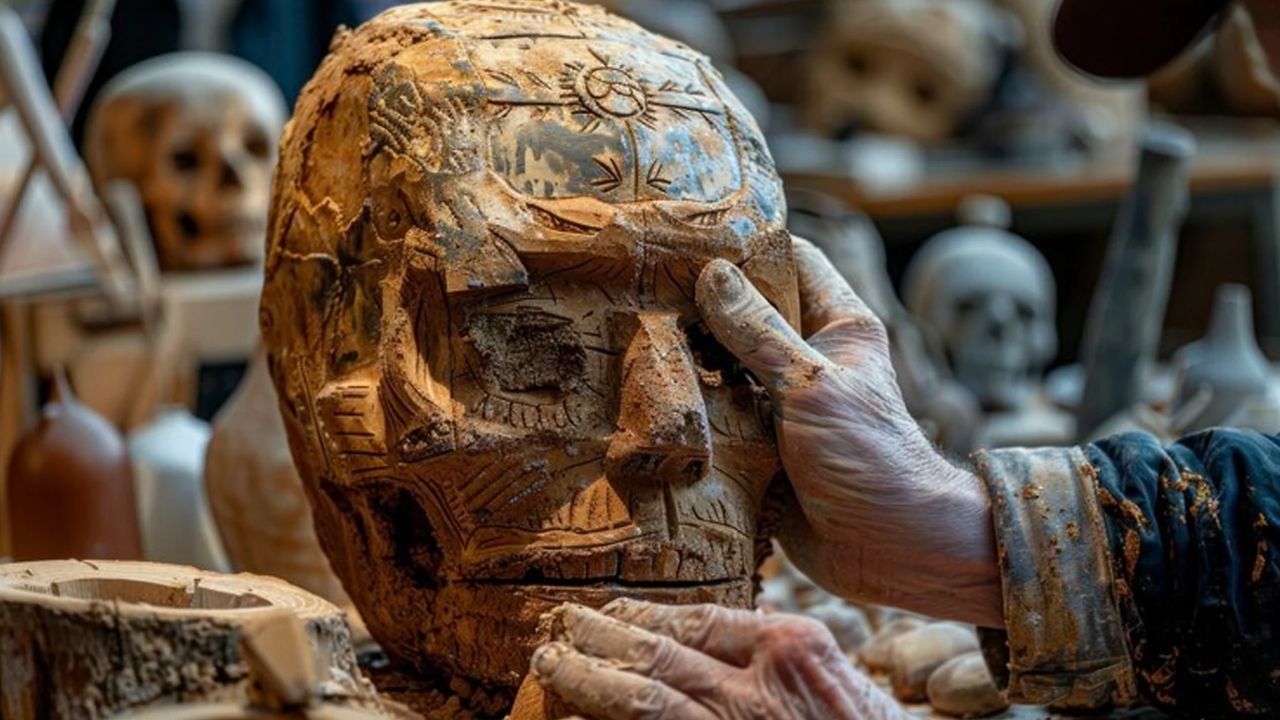The term “ancient artz” refers to the artistic traditions developed by early civilizations that laid the foundation for art as we know it today. From the refined sculptures of ancient Greece to the enigmatic cave paintings of prehistoric cultures, ancient art is a window into the past, revealing humanity’s first attempts at self-expression, storytelling, and preserving cultural identity. Each piece, whether etched in stone, carved from wood, or painted on walls, tells us about the customs, religious beliefs, and societal values of its creators, leaving an enduring legacy that continues to inspire modern art.
The Foundations of Ancient Artz
Understanding the essence of ancient art requires delving into the early methods and tools used by artists. Unlike today’s extensive materials and resources, ancient artists made use of readily available materials, such as clay, stone, wood, and natural pigments. These early artists focused on symbolic representations, often centering their work on spiritual themes, daily activities, or mythological figures. The art created was not solely for aesthetic pleasure but held profound religious, cultural, and communicative significance.
Ancient Artz and Its Cultural Roots
Each ancient civilization contributed uniquely to the world of art. From the monumental architecture of Mesopotamia to the elaborate hieroglyphics of Egypt, every ancient society expressed its values, beliefs, and history through its distinctive art forms. Art served as a form of documentation, with rulers, myths, and epic events immortalized through sculptures, murals, pottery, and more.
The Earliest Artistic Expressions: Prehistoric Art
The first known artworks are prehistoric, found on cave walls and dated back tens of thousands of years. These cave paintings and carvings, such as those in Lascaux Cave in France and Altamira Cave in Spain, illustrate the beginnings of human creativity. Depictions of animals, handprints, and abstract symbols highlight an early desire to record observations and perhaps connect with the spiritual world.
Mesopotamian Art: Pioneers of Civilization
The art of Mesopotamia, known as the “cradle of civilization,” includes some of the earliest depictions of city life, governance, and religion. Sumerian, Akkadian, Babylonian, and Assyrian art developed over centuries in this region, often characterized by detailed bas-reliefs, monumental statues, and cylinder seals. These works served both decorative and religious purposes, portraying gods, kings, and mythological creatures that emphasized the divine right of rulers and the spiritual nature of daily life.
The Symbolism and Grandeur of Ancient Egyptian Art
Egyptian art, synonymous with grandeur and mystique, has captivated historians and art enthusiasts for centuries. Pharaohs and gods are often the central figures in Egyptian art, symbolizing the connection between the divine and earthly realms. Pyramids, tomb paintings, and the iconic Sphinx of Giza represent the Egyptians’ profound beliefs in the afterlife and their desire to honor deities. Artifacts like the bust of Nefertiti and the treasures of Tutankhamun’s tomb continue to mesmerize with their beauty and craftsmanship.
Greek Art: The Birth of Western Artistic Ideals
Ancient Greece revolutionized art by focusing on realism, harmony, and idealized human forms. Greek sculpture, pottery, and architecture showcased advances in proportion and anatomy, reflecting philosophical and aesthetic ideals. Greek art also explored mythology, heroism, and civic pride, giving rise to iconic masterpieces such as the Parthenon sculptures and the statues of gods and heroes like Zeus, Athena, and Hercules. This era marked a shift towards celebrating human achievement and exploring natural beauty, principles that continue to shape Western art today.
Roman Art: Legacy of Realism and Innovation
Influenced by Greek art, Roman art emphasized realism and innovation, especially in portraiture, mosaics, and architecture. Romans excelled in creating lifelike sculptures and expansive frescoes depicting historical events, notable figures, and everyday scenes. They developed engineering marvels like aqueducts, temples, and amphitheaters—structures that were both functional and visually impressive. Roman mosaics, often found in luxurious villas, illustrate mythological scenes and are celebrated for their intricate designs and rich colors.
Asian Ancient Artz: Aesthetic Sophistication and Spiritual Depth
Ancient art from Asia, particularly from civilizations in China and India, reflects profound spiritual beliefs and a meticulous eye for detail.
Chinese Art: Harmony and Nature
Chinese ancient art, dating back to the Shang and Zhou dynasties, often centers on nature, spirituality, and harmony. Calligraphy, jade carving, and porcelain are among China’s unique contributions, symbolizing balance, longevity, and natural beauty. Chinese art was also deeply influenced by Confucian and Taoist philosophies, aiming to represent moral virtues and cosmic harmony.
Indian Art: Spiritual Narratives and Ornate Design
India’s ancient art, especially in the form of sculptures and temple carvings, celebrates spiritual narratives. Hinduism and Buddhism heavily influenced Indian art, resulting in elaborate temple structures and sculptures, such as the Ellora and Ajanta Caves. Representations of deities like Vishnu, Shiva, and Buddha highlight the deep-seated religious beliefs, while the art of dance, as seen in sculptures, brings a dynamic sense of movement and spirituality.
Mesoamerican Art: Rituals, Symbols, and Societal Structure
The ancient civilizations of Mesoamerica, including the Maya, Aztecs, and Olmecs, crafted art rich in symbolism and ritual significance. These societies created complex iconography to honor gods, record history, and mark astronomical events. Structures like the pyramids of Teotihuacan and the Maya city of Chichen Itza exhibit architectural prowess and artistic creativity. Mesoamerican art often utilized materials like jade, obsidian, and feathers, embedding their artifacts with spiritual and cultural meaning.
African Art: Tribal Heritage and Sacred Objects
In Africa, ancient art is often linked with religious and social rituals, highlighting the continent’s deep spiritual heritage. Artifacts such as masks, statues, and bronze carvings from cultures like the Nok and Benin provide insights into early African societies. These artworks were primarily created for ceremonies, representing gods, ancestors, and animals to bridge the physical and spiritual worlds. African art from this era is celebrated for its powerful symbolism, rhythmic forms, and bold, stylized figures.
Ancient Artz Techniques and Materials
One of the most intriguing aspects of ancient art is the array of techniques and materials that early artists employed. From tempera painting in Egyptian tombs to the lost-wax casting in African bronzes, each civilization developed specialized methods that reflect its resources and environment. Stone carving, metalwork, pottery, weaving, and mural painting were popular practices, each requiring significant skill and craftsmanship. The materials used, such as clay, metals, ivory, and pigments derived from plants and minerals, further shaped the style and durability of these ancient artworks.
Symbolism and Spirituality in Ancient Artz
Ancient art is marked by rich symbolism, often reflecting the religious and cultural beliefs of the society. In Egyptian art, for instance, the ankh symbolized life, while animals in prehistoric art might have represented totems or deities. These symbols conveyed messages that transcended time, offering insight into ancient philosophies and the connection between humanity and the divine.
Legacy and Influence of Ancient Artz on Modern Society
Ancient art has had a lasting influence on contemporary art and architecture. The aesthetic principles, techniques, and themes pioneered by ancient cultures continue to inspire artists today, seen in the revival of classical Greek and Roman styles during the Renaissance and the ongoing admiration for Egyptian and Mesopotamian motifs. Modern art movements often revisit ancient symbolism and themes, finding relevance in the timeless messages and artistic expressions crafted thousands of years ago.
Exploring Ancient Artz in Museums and Archaeological Sites
To appreciate ancient art fully, many seek out museums and archaeological sites that house these treasures. Institutions like the British Museum, the Louvre, and the Metropolitan Museum of Art feature extensive collections from ancient Egypt, Greece, Mesopotamia, and beyond. Additionally, visiting archaeological sites, such as the Pyramids of Giza, the Parthenon in Greece, and Machu Picchu in Peru, offers a firsthand experience of ancient architecture and artistry.
Ancient Artz: Preserving the Cultural Legacy
Today, the preservation of ancient art faces challenges due to environmental factors, human activity, and political instability. Conservation efforts are crucial to maintaining these artifacts, as they are invaluable records of human history. Restorative practices, such as climate-controlled environments in museums and innovative preservation techniques at historical sites, play a significant role in ensuring that future generations can continue to learn from and appreciate ancient art.
Conclusion
The legacy of ancient artz continues to captivate and inspire people across the globe. By exploring these early forms of art, we gain invaluable insights into the lives, beliefs, and aspirations of ancient civilizations. Their artistic expressions, crafted thousands of years ago, bridge time and place, offering a timeless reflection of human culture and creativity. Through preservation and appreciation, we keep the spirit of ancient art alive, ensuring that its beauty and meaning endure for generations to come.
FAQs
What is ancient artz?
Ancient artz refers to the artistic traditions developed by early civilizations. These works reflect cultural, religious, and societal values, often incorporating symbolism and craftsmanship that offer insight into past human experiences.
Why is ancient art important?
Ancient art is a record of humanity’s first attempts at self-expression, documenting beliefs, societal structures, and daily life. Its preservation allows us to understand and appreciate the cultural diversity and heritage of early civilizations.
Where can I see examples of ancient artz?
Many museums worldwide house collections of ancient art, including the British Museum, the Louvre, and the Metropolitan Museum of Art. Archaeological sites, such as the Pyramids of Giza and the ruins of Pompeii, also showcase ancient art.
How did ancient artists make their works?
Ancient artists used natural materials, such as clay, stone, metals, and pigments, to create their works. They employed techniques like carving, painting, and casting, each adapted to their environment and available resources.
What are some famous ancient artworks?
Famous examples include the Sphinx and the Great Pyramids of Egypt, Greek sculptures like the Venus de Milo, and the Terra Cotta Army in China. These works are celebrated for their skill, size, and cultural significance.
What challenges face the preservation of ancient artz?
Environmental factors, human interference, and natural decay are significant challenges. Conservation efforts, including restoration and protective measures, are crucial for preserving these works for future generations.





